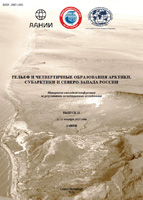| ||
|
| ||
|
doi: 10.24412/2687-1092-2024-11-483-490 Earth Cryosphere Institute of Tyumen Research Centre SB RAS, Tyumen, Russia
|
|
Abstract. The results of our observations, published and archival data of the permafrost temperature in the Western Arctic are presented. Long-term trends of the Permafrost temperature increase have been determined for 16 key sites on the coast of the Barents and Kara Seas. For the Barents Sea coast, the average temperature rise trend was 0.028 °C/year. For the Kara Sea, the average trend reaches 0.056 °C/year. GIS-oriented maps of the Permafrost temperature trends in Western Arctic have been developed. It has been found that trends remain unchanged on the coast of the Barents Sea, in the contrast, trends tend to increase on the Kara Sea coast. Keywords: Western Arctic, permafrost, temperature, temperature trends.
REFERENCES: Brown J., Hinkel K.M., Nelson F.E. The circumpolar active layer monitoring (CALM) program: research designs and initial results // Polar Geography. 2000. Vol. 24. Is. 3. P. 166-258. doi: 10.1080/10889370009377698 Burn C.R. The Thermal Regime of Cryosols. Cryosols (Permafrost-Affected Soils). J. Kimble (ed.). Berlin–Heidelberg– New York, Springer-Verlag, 2004. P. 391–414. Gorelik Ya.B., Soldatov P.V. Engineering-geological conditions of the Yamburg gas field and boreholes areas // Earth Cryosphere. 2015. Vol. XIX. № 1. P. 58–69. IPCC, 2018: Global Warming of 1.5°C. An IPCC Special Report on the impacts of global warming of 1.5°C above pre-industrial levels and related global greenhouse gas emission pathways, in the context of strengthening the global response to the threat of climate change, sustainable development, and efforts to eradicate poverty /Masson-Delmotte V., P. Zhai H.-O. Pörtner et al. (eds.). Cambridge University Press, Cambridge, UK and New York, NY, USA, 616 p. doi: 10.1017/9781009157940 Malkova G.V., Korostelev Yu.V., Sadurtdinov M.R. et al. Permafrost Degradation in European North of Russia under climate warming // Proceeding of all Russian conference “III Yudakhin memory”, Arkhangelsk, June 25-28, 2024. P. 248-253. Maslov A.D. Physical-mechanical and thermophysical properties of bottom sediments of the southeastern part of the Barents and southwestern parts of the Kara Seas // Engineering and geological properties of bottom sediments of the World Ocean. Leningrad, Sevmorgeologiya, 1985, pp. 51-63. Romanovsky V.E. The thermal regime of the permafrost in Alaska in the last 20 years // Proceedings of the International Conference "Theory and practice of assessing the state of the Earth's cryosphere and forecasting its changes", vol. 1, Tyumen, Tyumen State University. 2006. P. 96-101. Vasiliev A.A., Gravis A.G., Gubarkov A.A. et al. Permafrost Degradation; Results of the long-term Permafrost monitoring in the western sector of Russian Arctic // Earth Cryosphere. 2020. Vol. XXIV. № 2. P. 15–30. doi: 10.21782/KZ1560-7496-2020-2(15-30)
|
|
Cite this article: Vasiliev A.A., Malkova G.V., Oblogov G.E., Khomutov A.V. Permafrost degradation trends of western Russian Arctic // Relief and Quaternary deposits of the Arctic, Subarctic and North-West Russia. 2024. Issue 11. P. 483-490. doi: 10.24412/2687-1092-2024-11-483-490
|

